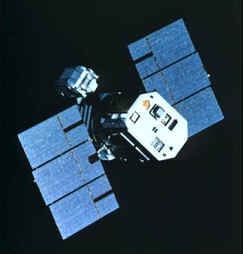SMM (Solar Maximum Mission)

Solar Maximum Mission (SMM) was a NASA spacecraft equipped to study solar flares and other high-energy solar phenomena. Launched during a peak of solar activity, SMM observed more than 12,000 flares and over 1,200 coronal mass ejections during its 10-year lifetime. It provided measurements of total solar radiative output, transition region magnetic field strengths, storage and release of flare energy, particle accelerations, and the formation of hot plasma. Observations from SMM were coordinated with in situ measurements of flare particle emissions made by ISEE-3 (International Sun-Earth Explorer 3). SMM was the first satellite to be retrieved, repaired, and redeployed in orbit: in 1984, the STS-41 Shuttle crew restored the spacecraft's malfunctioning attitude control system and replaced a failed electronics box. SMM collected data until 24 November 1989.
| launch date | Feb 14, 1980 |
| launch vehicle | Delta 3914 |
| launch site | Cape Canaveral |
| orbit | 405 × 408 km × 28.5° |
| mass | 2,315 kg |
| length | 4.0 m |


